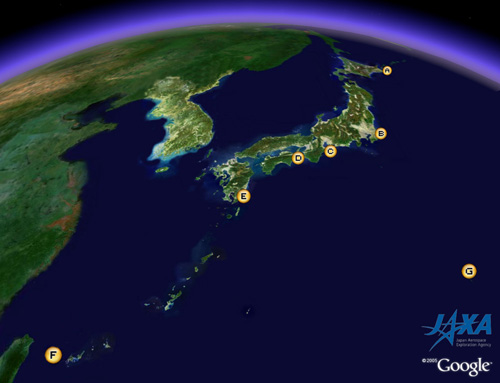Seen from Space 2006
Observing the New Year's First Sun Rising over the Ocean
From Chichi-jima and Haha-jima in the Ogasawara-shoto area (Frame G), you can see the earliest sunrise in generally habitable regions of Japan. Chichi-jima is located about 1,000 km south of Tokyo, and Haha-jima is situated about 50 km south of Chichi-jima. They are sometimes called the "Galapagos of the Orient" because there are many animals and plants there that are endemic to only that area. Inubo-saki in Chiba Prefecture in Frame B is where you can see the next earliest New Year's sunrise in Japan (except for the heights and isolated islands). A large stratum exposed in the Cretaceous Period in Byobuga-ura to the west of Inubo-saki has caused the area to be called the "Dover of the Orient." The mouth of the Tonegawa River on the northern side of Inubo-saki has the largest basin in Japan. Sawara and Itako to the west-northwest of Inubo-saki are riverside districts. Sawara is the home town of Tadataka Ino who created Dai-Nippon-Enkai-Yochi-Zen-Zu (Complete Japan shoreline Chart) about 200 years ago. There are two famous shrines there, Katori-jingu in Sawara and Kashima-jingu in Kashima to the east of Itako. You can see Kashima Port, an artificial port built by digging and dredging from 1965 to 1979. From Nosappu-misaki in Hokkaido (Frame A), you can see the earliest sunrise in Hokkaido and Tohoku (except for the Northern Territories and higher elevations). Lake Furen and Lake Onneto at the base of the Nemuro Peninsula are frozen over at this time of year. The earliest New Year's sunrise in the Kinki district can be seen from Daio-zaki in Mie Prefecture (Frame C). Daio-zaki is located on the south-east end of Shima Peninsula; its circumferential area is designated as the Ise-Shima National Park. Frame C also depicts Ago Bay, famous for pearl culturing, and the Shima Spanish Village near Daio-zaki. Toba City to the north is the location of Shinju-jima (Pearl Island) where, in 1893, Kokichi Mikimoto succeeded in culturing pearls for the first time in the world. Ise-jingu is located west of Toba City and is separated into two parts, Naiku (the Inner Shrine) and Geku (the Outer Shrine). Between Ise and Toba there is Meoto-iwa (husband and wife rocks), often featured on New Year's TV programs. The earliest New Year's sunrise in the Chugoku and Shikoku districts can be seen from Gamoda-misaki in Tokushima Prefecture (Frame D). Gamoda-misaki is known as the spawning place of the loggerhead sea turtle. You can see the Yoshino River and Tokushima, which is famous for the Awa Odori dance, to the north of Gamoda-misaki. You can also see the Oh-Naruto-kyo Bridge that links Shikoku and Awaji-shima farther north. The earliest New Year's sunrise in Kyushu can be seen from Toi-misaki in Miyazaki Prefecture (Frame E). Toi-misaki is located on the Southernmost Point of the Nichinan Coast Quasi National Park and is home to about 100 "Toi wild horses," that is a kind of natural treasures. Oni-no-Sentakuita (Devil's washboard; a wavelike rock) is also a natural treasure to the north of the Nichinan Coast. Udo-jingu and Aburatsu Harbor, which have prospered since the 14th century, can be seen in the middle of the Nichinan Coast. The latest New Year's sunrise in Japan occurs in Yonaguni-jima, Okinawa Prefecture (Frame F). The world's largest moth dubbed "Yonaguni-san" (another natural treasure) inhabits this area. On the eastern end of the island is Agari-zaki, and on the western end is Iri-zaki, which is the westernmost tip of Japan. The following table lists these New Year's sunrise observation points with their times, remarks, and other detailed information.
JAXA will launch the Advanced Land Observing Satellite (ALOS) in the near future. It will carry the Advanced Visible and Near Infrared Radiometer 2 (AVNIR-2), which has a 10 m ground resolution. At that time, we will be able to distribute clearer images.
|
||||||||||||||||||||||||||||||||||||||||||||||||||||||||||||||||||||||||||||||||||||||||||||||||||||||||||||||||||||





